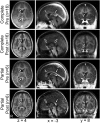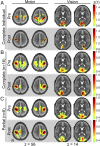On the role of the corpus callosum in interhemispheric functional connectivity in humans
- PMID: 29183973
- PMCID: PMC5740665
- DOI: 10.1073/pnas.1707050114
On the role of the corpus callosum in interhemispheric functional connectivity in humans
Abstract
Resting state functional connectivity is defined in terms of temporal correlations between physiologic signals, most commonly studied using functional magnetic resonance imaging. Major features of functional connectivity correspond to structural (axonal) connectivity. However, this relation is not one-to-one. Interhemispheric functional connectivity in relation to the corpus callosum presents a case in point. Specifically, several reports have documented nearly intact interhemispheric functional connectivity in individuals in whom the corpus callosum (the major commissure between the hemispheres) never develops. To investigate this question, we assessed functional connectivity before and after surgical section of the corpus callosum in 22 patients with medically refractory epilepsy. Section of the corpus callosum markedly reduced interhemispheric functional connectivity. This effect was more profound in multimodal associative areas in the frontal and parietal lobe than primary regions of sensorimotor and visual function. Moreover, no evidence of recovery was observed in a limited sample in which multiyear, longitudinal follow-up was obtained. Comparison of partial vs. complete callosotomy revealed several effects implying the existence of polysynaptic functional connectivity between remote brain regions. Thus, our results demonstrate that callosal as well as extracallosal anatomical connections play a role in the maintenance of interhemispheric functional connectivity.
Keywords: callosotomy; corpus callosum; functional connectivity; resting state; structural connectivity.
Copyright © 2017 the Author(s). Published by PNAS.
Conflict of interest statement
Conflict of interest statement: E.C.L. discloses financial relationships with the following companies: Intellectual Ventures, Monteris Medical, Acera Medical, Pear Therapeutics, General Sensing, Immunovalent, Face to Face Biometrics, Neurolutions, and Osteovantage.
Figures





References
-
- Snyder AZ. Intrinsic brain activity and resting state networks. In: Pfaff DW, Volkow ND, editors. Neuroscience in the 21st Century. Springer; New York: 2016. pp. 1–52.
-
- Leuthardt EC, et al. Resting-state blood oxygen level-dependent functional MRI: A paradigm shift in preoperative brain mapping. Stereotact Funct Neurosurg. 2015;93:427–439. - PubMed
Publication types
MeSH terms
Grants and funding
LinkOut - more resources
Full Text Sources
Other Literature Sources

